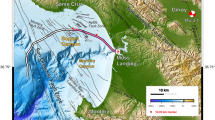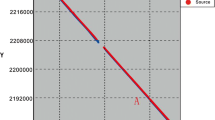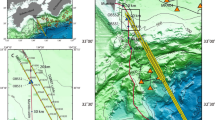Abstract
The paper addresses marine broadband seismic data acquisition technologies, including conventional seismic oil exploration (frequencies no higher than a few tens of hertz) to map the subsurface down to several kilometers and engineering seismic surveying (frequencies from a few hundred to a few thousand hertz) to characterize sediments within the upper several hundred meters below the seabed. Various methods and approaches used in the two kinds of surveying have a lot in common, although they belong to different specializations. For the first time, this problem is discussed from a single point of view. We used published materials by foreign geophysical companies and experimental data obtained with acquisition techniques that we modified for two-tiered observations. It is shown that the modified techniques are efficient in the Arctic, especially for studying permafrost in upper subseabed sediments. This paper also discusses the application of towed recording systems and ocean floor multicomponent streamer cables and stations, including those using fiber optic technologies. Fiber optic receiver systems are most efficient for seismic time-lapse monitoring of oil and gas reservoirs during production (4D seismic). Analysis of the common problems with conventional and high-frequency marine seismic surveys allows the conclusion that it is time to revise the long-standing concept of marine seismic data acquisition. One possible way is to develop an integrated system for the acquisition, processing, and interpretation of seismic data in all frequency ranges. Our findings can aid in develo** a methodology for geophysical surveying in hard-to-reach water areas.













Similar content being viewed by others
REFERENCES
Ampilov, Yu.P., Pogloshchenie i rasseyanie seismicheskikh voln v neodnorodnykh sredakh (Attenuation and Scatter of Seismic Waves in Inhomogeneous Media), Moscow: Nedra, 1992.
Ampilov, Yu.P., Seismicheskaya interpretatsiya: opyt i problemy (Interpretation of Seismic Data: Experience and Problems), Moscow: Geoinformmark, 2004.
Ampilov, Y.P., From Seismic Interpretation to Modeling and Assessment of Oil and Gas Fields, Houten, Netherlands: EAGE Publ., 2010.
Ampilov, Yu.P., Seismic exploration on the Russian Shelf, Offshore (Russia), 2015a, no. 2, pp. 26–33.
Ampilov, Yu.P., Comparison of alternative technologies for broadband marine seismic exploration, Tekhnol. Seismorazved., 2015b, no. 2, pp. 77–85.
Ampilov, Y.P., Problems of using modern seismic technology on the Russian shelf, Geomodel 2015 – 17th Scientific-Practical Conference on Oil and Gas Geological Exploration and Development, Gelendzhik, Russia, 2015c, pp. 355–359.
Ampilov, Y.P., Offshore seismic equipment. A window of opportunity for import substitution, Offshore (Russia), 2017, no. 2, pp. 22–25.
Ampilov, Y.P. and Baturin, D.G., Latest marine geophysical technologies for comprehensive study of natural hydrocarbon reservoirs and monitoring, SPE Russian Oil and Gas Exploration and Production Technical Conference and Exhibition, Moscow, 2012, vol. 3, pp. 2056–2063.
Ampilov, Yu.P. and Baturin, D.G., The leading-edge technologies of 4D seismic monitoring when marine development of oil and gas fields, Tekhnol. Seismorazved., 2013, no. 2, pp. 31–36.
Ampilov, I.P., Bezmaternykh, E.F., Malovitskii, J.P., and Oblogina, T.I., New possibilities for the study of earth crust via absorption of seismic waves, Dokl. Akad. Nauk SSSR, 1990, vol. 310, no. 6, pp. 1331–1334.
Ampilov, Yu.P., Barkov, A.Yu., Yakovlev, I.V., Philip-pova, K.E., and Priezzhev, I.I., Almost everything on seismic inversion. Pt. I, Tekhnol. Seismorazved., 2009, no. 4, pp. 3–16.
Baardman, R.H., Verschuur, D.J., van Borselen, R.G., and Frijlink, M., Estimation of primaries by sparse inversion using dual-sensor data, SEG Technical Program Expanded Abstracts, 2010, pp. 3468–3472. https://doi.org/10.1190/1.3513569
Badrieva, A.F. and Vladov, M.L., Evaluation of the possibility of using antennas with finite area in ground-penetrating radar research without direct contact with the medium, Moscow Univ. Geol. Bull., 2013, vol. 68, no. 1, pp. 52–59.
Barkved, O.I., Seismic Surveillance for Reservoir Delivery: From a Practitioner’s Point of View, Houten, Netherlands: EAGE, 2012.
Day, A., Cambois, G., Carlson, D., Jones, C., Lesnes, M., Sollner, W., and Tabti, H., Dual-sensor streamer data, acquisition QC and attenuation of seismic interferences and other noises, 71th EAGE Conference and Exhibition incorporating SPE EUROPEC 2009, Vienna, Austria, 2009. https://doi.org/10.3997/2214-4609.201400517
Day, A., Klüver, T., Söllner, W., Tabti, H., and Carlson, D., Wavefield-separation methods for dual-sensor towed-streamer data, Geophysics, 2013, vol. 78, no. 2, pp. WA55–WA70. https://doi.org/10.1190/geo2012-0302.1
Egorov, A., Glubokovskikh, S., Bóna, A., Pevzner, R., Gurevich, B., and Tokarev, M., How rough sea affects marine seismic data and deghosting procedures, Geophys. Prospect., 2018, vol. 66, no. 1, pp. 3–12.
Foreste, K., Robertson, J., and Boekholt, M., Practice and results of the first 4D marine seismic surveys in Russia (Sakhalin shelf), Materialy 7-i konferentsii “Shel’f Rossii 2012” (Russian Shelf 2012: Proceedings of the 7th Conference), Moscow, 2012.
Fromyr, E., Pharez, S.J., and Ampilov, Y., A ghost-free solution for marine seismic acquisition, “Geosciences: Making the Most of the Earth’s Resources,” 3rd Saint Petersburg International Conference and Exhibition, St. Petersburg, Russia, 2012. https://doi.org/10.3997/2214-4609.20143688
Gaynanov, V.G., Tokarev, M.U., and Zverev, A.S., Offshore seismoacoustic survey technology – from two frequency profiling to multichannel systems, “Geosciences: From New Ideas to New Discoveries,” 3rd Saint Petersburg International Conference and Exhibition on Geosciences, St. Petersburg, Russia, 2008. https://doi.org/10.3997/2214-4609.20146893
Isaenkov, R., Ponimaskin, A.I., and Tokarev, M.J., Processing workflow for the dynamic interpretation of very-high-resolution P-wave seismic data, EAGE Near Surface Geoscience 2016 – Second Applied Shallow Marine Geophysics Conference, Barcelona, Spain, 2016. https://doi.org/10.3997/2214-4609.201602154
Kalinin, A.V., Kalinin, V.V., and Pivovarov, B.L., Seismoakusticheskie issledovaniya na akvatoriyakh (Seismoacoustic Studies in Water Areas), Moscow: Nedra, 1983.
Kalinin, V.V., Vladov, M.L., and Egorov, A.A., The possibility of creating unidirectional antennas of small wave sizes for seismic prospecting. Part 3. Analysis of the possibility of using as part of bottom loggers, Tekhnol. Seismorazved., 2014, no. 3, pp. 79–84.
Long, A., A bigger picture view of separated wavefields and marine broadband seismic, First Break, 2017, vol. 35, no. 6, pp. 81–86.
Oshkin, A., Fokin, I., Tikhotsky, S., Vladov, M., and Bershov, A., Seismoacoustic raying for the survey of concrete and masonry structures, 10th EAGE Scientific and Practical Conference and Exhibition on Engineering Geophysics, Gelendzhik, Russia, 2014. https://doi.org/10.3997/2214-4609.20140370
Roslov, Yu.V., Voronov, M.A., and Dolotkazin, I.N., Technology of multicomponent bottom seismic survey on the basis of Turtle-500 modules, Prib. Sist. Razved. Geofiz., 2014, no. 2, pp. 37–46.
Shmurak, D.S., Ermakov, A.P., and Vladov, M.L., Near surface seismic of karst areas, Engineering Geophysics 2016: 12th EAGE Conference and Exhibition, Anapa, Russia, 2016, pp. 150–153.
Terekhina, Y.E. and Tokarev, M., Integrated acoustic and sampling data for seabed map** in Kandalaksha bay the White sea, EAGE Near Surface Geoscience 2014 – First Applied Shallow Marine Geophysics Conference, Athens, Greece, 2014. https://doi.org/10.3997/2214-4609.20142131
Tokarev, M., Kuzub, N., Pevzner, R., Kalmykov, D., and Bouriak, S., High resolution 2D deep-towed seismic system for shallow water investigation, First Break, 2008, vol. 26, no. 4. P.77–85.
Tokarev, M.Yu., Gaynanov, V.G., and Kulnitsky, L.M., RF patent no. 2592739, July 27, 2016.
Van Gestel, J.P., Kommedal, J., Barkved, O., Mundal, I., Bakke, R., and Best, K., Continuous seismic surveillance of Valhall Field, The Leading Edge, 2008, vol. 26, pp. 1616–1621.
Veeken, P.C.H., Priezzhev, I., Shmaryan, L.E., Shteyn, Y.I., Barkov, A.Y., and Ampilov, Y.P., Nonlinear multitrace genetic inversion applied on seismic data across the Shtokman field, offshore northern Russia, Geophysics, 2009, vol. 74, no. 6. https://doi.org/10.1190/1.3223314
Vladov, M.L. and Eletskaya, S.S., Morskaya seismometriya (Marine Seismometry), Moscow: KDU, 2016.
Vladov, M.L., Nikolaeva, S.K., Oshkin, A.N., and Pioro, E.V., Deformation characteristics of quaternary clay soils by results of engineering-geological and ultrasonic research, Geofizika, 2015, no. 4, pp. 27–31.
Vladov, M.L., Bricheva, S.S., Struchkov, V.A., and Tokarev, M.Yu., Estimating potential of the laboratory measurements of nonconsolidated sediments with the use of an electrospark source of elastic waves and piezoelectric pressure receivers, Tekhnol. Seismorazved., 2016, no. 3, pp. 114–122.
Yakovlev, I.V., Ampilov, Yu.P., and Philippova, K.E., Almost everything on seismic inversion. Pt. II, Tekhnol. Seismorazved., 2011, no. 1, pp. 5–15.
ACKNOWLEDGMENTS
We are grateful to Petroleum Geo-Services (PGS) for permission to use some illustrative materials produced when one of the authors worked for the company.
Funding
The article was prepared under the Program for Development of Hardware and Software Systems for Prospecting, Exploration, and Geophysical and Geochemical Monitoring of Hydrocarbon Field Development, Including in Hard-to-Reach Regions and Severe Climatic Environments, and was supported by the Ministry of Education and Science of the Russian Federation, agreement no. 14.607.21.0187 of September 26, 2017 (Unique identifier RFMEFI60717X0187).
Author information
Authors and Affiliations
Corresponding author
Additional information
Translated by B. Shubik
About this article
Cite this article
Ampilov, Y.P., Vladov, M.L. & Tokarev, M.Y. Broadband Marine Seismic Acquisition Technologies: Challenges and Opportunities. Seism. Instr. 55, 388–403 (2019). https://doi.org/10.3103/S0747923919040030
Published:
Issue Date:
DOI: https://doi.org/10.3103/S0747923919040030




